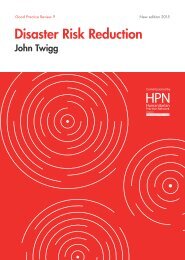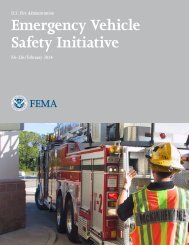Observer
2aEAQDf
2aEAQDf
You also want an ePaper? Increase the reach of your titles
YUMPU automatically turns print PDFs into web optimized ePapers that Google loves.
Looking Through<br />
Different Filters<br />
Culture and Bureaucracy<br />
in the Aftermath of<br />
Disaster<br />
By Nnenia Campbell<br />
Lyons, Colorado, two months after the<br />
flood along newly reopened US-36,<br />
November 16, 2013 © Kent Kanouse<br />
For decades, disaster researchers have attempted<br />
to call attention to the problematic outcomes of disasterresponse<br />
organizations’ tendency to discount local expertise,<br />
culture, and capacity in the interest of efficiency and<br />
standardization (Quarantelli 1988, Dynes 1994; Drabek<br />
and McEntire 2003; Schneider 1992; Takeda and Helms<br />
2006). These outside groups are tasked with restoring order<br />
in communities whose basic functions have been paralyzed<br />
by crisis, and there is generally some truth to their<br />
assumptions of local paralysis. Most scholars agree that<br />
a defining characteristic of disasters is the disruption of<br />
a community’s essential functions (Fritz 1961; Alexander<br />
2005; Perry 2007). People’s daily lives cease to operate normally<br />
because the systems that support them have been<br />
overwhelmed by the event.<br />
Yet, in an effort to restore a sense of normalcy, outside<br />
disaster response groups often take over entirely, despite<br />
knowing little about the local setting. This command-andcontrol<br />
approach has created conflict in disaster-stricken<br />
communities, hindered the effectiveness of local disasterrelief<br />
activities, and introduced additional delays into the<br />
disaster-recovery process. Further, such practices have in<br />
some cases eroded local autonomy and suppressed officials’<br />
ability to approach solutions in ways that are appropriate<br />
for their community’s needs.<br />
The experience of several small mountain communities<br />
in Boulder County, Colorado, following the 2013 flood disaster<br />
provides an apt case study of how command-andcontrol<br />
policies have played out, and how organizational<br />
practices need to be adapted to reduce risk of secondary<br />
trauma and other unintended consequences that often<br />
harm communities in the aftermath of disaster. Residents<br />
in these mountain communities tend to maintain values of<br />
self-reliance, autonomy, and shared identity to a far greater<br />
extent than those in nearby urban environments. The<br />
unforgiving landscapes tend to attract people who seek<br />
to embody such values, as geographic isolation and omnipresent<br />
environmental hazards require residents to be<br />
resilient. For example, dizzyingly winding roads become<br />
treacherous in icy winter conditions, so mountain communities<br />
cannot depend on the conveniences of the flatlands.<br />
Wildfire threats require further vigilance and readiness. In<br />
fact, actual wildfires in the region have caused devastating<br />
destruction that has lingered in the collective memory.<br />
Yet this remote environment has held a certain appeal for<br />
people looking to escape the crowds and consumerism of<br />
the cities. Over time, residents of these isolated communities<br />
have developed a sense of strength and resolve.<br />
This work has been informed by a variety of data sources.<br />
These include in-depth interviews with 40 residents1<br />
and 30 community stakeholders and analysis of more than<br />
100 documentary sources conducted as part of a separate<br />
research project. In seeking to specifically focus in on the<br />
ways in which cultural dynamics shaped locals’ interactions<br />
with outside agencies in the aftermath of the 2013<br />
floods, I collaborated with a community representative to<br />
gather insights from 13 individuals in the western mountains<br />
of Boulder County. These stakeholders responded to<br />
the floods in a variety of different capacities. They ranged<br />
from emergency management personnel to representatives<br />
of local and national nonprofit organizations, government<br />
officials, and recovery workers in addition to residents<br />
themselves.2 While the experiences detailed below<br />
highlight issues unique to the cultural landscape of this<br />
1 In order to preserve anonymity, respondents were given pseudonyms.<br />
2 It is important to note that there is significant variation between these<br />
communities, including differences in infrastructure, governance, social<br />
networks, and subcultures. For example, some are statutory towns and<br />
thus have more-or-less formal government structures, including a capacity<br />
for collective representation, internal cohesion, and local infrastructure.<br />
However, others are unincorporated. Thus, lacking jurisdictional linkages<br />
to municipalities, residents in these areas pursue collective organization<br />
dynamically through local leaders as needs emerge. In this article I focus<br />
primarily on the experiences of communities that are historical towns,<br />
regardless of legal status.<br />
16 Natural Hazards <strong>Observer</strong> • June 2016







